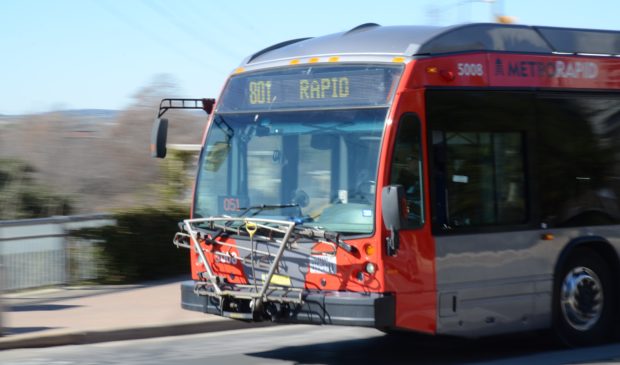Shorter headways create mild headaches for Capital Metro
Monday, March 5, 2018 by
Caleb Pritchard Ever since the Capital Metropolitan Transportation Authority began operating its two MetroRapid routes at 10-minute intervals during daytime hours, the agency has seen an uptick in an unwelcome phenomenon of buses of the same line running back to back.
The bunching, which has been reported on social media, had made it onto the radar of City Council Member Delia Garza who, in her position as a Capital Metro board member, asked about it during the board’s quarterly operations briefing at last Monday’s meeting.
“We have seen increasing occurrences of bus bunching, but because you have increased frequency you have more opportunities to bunch,” Dottie Watkins, Capital Metro’s vice president of bus and paratransit services told her.
Despite the increased bunching, the two MetroRapid lines – the No. 801 and the No. 803 – operated on time 83.8 percent of the time in the first quarter, just beating out the agency’s goal of 83 percent.
Watkins explained to the Austin Monitor that the on-time performance is measured by the published headways, or operating intervals, rather than a conventional schedule.
“We’re looking at, ‘Did this bus leave the station 10 minutes after the bus in front of it left the station?’ We say the bus is late if it’s more than 50 percent of the published frequency late,” she explained.
In other words, if a No. 801, which is supposed to arrive every 10 minutes, takes that amount of time plus 50 percent – or a total of 15 minutes – it will be officially marked as late.
For less-frequent routes that rely on timetables, early arrivals and departures are counted against their punctuality, Watkins told the Monitor.
“However, if I tell you the bus is going to come every 10 minutes, but you end up only having to wait for five minutes, from a customer’s standpoint that’s not a bad thing, so we don’t penalize (MetroRapid) for early departures,” she said.
But when a bus arrives early, that could mean the next bus will arrive outside of the promised 10-minute frequency, so it’s important for the agency to get a handle on the bunching. Watkins told the board on Monday that a dedicated dispatcher monitors the MetroRapid routes and helps advise drivers remotely.
Drivers are also adapting to new technology on board in the form of mobile terminals that display relative bus locations along the length of the route.
“We found that our MetroRapid operators were looking at the dynamic signs regularly to see where the bus behind them was, but they never knew where the bus in front of them was,” Watkins said, referring to the real-time arrival displays at MetroRapid stops.
Experts say bunching can be nipped in the bud at the moment a bus starts its run.
“That’s where the agency has the most control over its routes,” Chris Pangilinan, technology and rider engagement program director at New York-based Transit Center, told the Monitor. “Essentially, if you leave a terminal bunched, you’re not going to recover. If you leave a terminal even close to bunched, you’re going to collapse to bunching.”
But some factors lie beyond an agency’s direct control, Pangilinan noted.
“You’re looking also at cooperation with the city to make sure that there’s bus lanes and transit signal priority and other measures to make sure they can run as smoothly and without delay as possible on city streets,” he said.
Capital Metro and the Transportation Department have engaged in regular discussions regarding transit priority in recent months, and the forthcoming Austin Strategic Mobility Plan is expected to feature the fruits of those talks.
Speaking for the agency, Watkins said, “Our lives would be exponentially better if we had transit priority lanes, and our experience downtown has been very positive. We’re able to move a lot of people through a very congested downtown because we’ve got the transit priority lane. Obviously, it doesn’t make sense to give us a transit priority lane where the congestion is not that bad or where our transit frequency and throughput aren’t that high, but in the core of central Austin, the more of that we can get, the better.”
Photo by John Flynn.
The Austin Monitor’s work is made possible by donations from the community. Though our reporting covers donors from time to time, we are careful to keep business and editorial efforts separate while maintaining transparency. A complete list of donors is available here, and our code of ethics is explained here.
You're a community leader
And we’re honored you look to us for serious, in-depth news. You know a strong community needs local and dedicated watchdog reporting. We’re here for you and that won’t change. Now will you take the powerful next step and support our nonprofit news organization?









